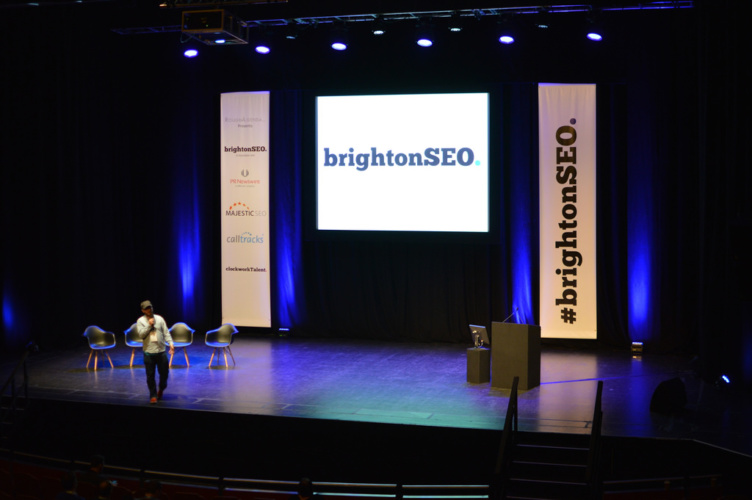
Over the past few years, BrightonSEO has established itself as a top destination for SEOs and marketers from around the globe. If you’ve never experienced it before, you should definitely grab a free ticket and absorb some of the SEO goodness on offer!
The conference features a number of different talks from industry leaders who share their successes and failures to help us become better search marketers. You can expect to meet lots of like-minded individuals, bump into industry legends, and pick up plenty of free swag on the way (which is arguably the best part).
This year’s conference was definitely worth the trip. While the talks are always pretty varied, the tips and tactics shared are usually white hat only. This year was slightly different as there was a whole track on ‘grey hat SEO’ including a talk on PBNs. This opened up the debate on white hat vs. black hat SEO and there seems to be lots of confusion on the subject.
Here are some key takeaways from BrightonSEO, focusing on the different black hat/white hat tactics that were featured.
When Does White Hat Become Grey Hat?
This is an interesting one. Your classic white hat tactics usually revolve around PR and landing coverage on top publications. Some would consider your standard guest post to be black hat while PBNs are 100% a black hat tactic.
The truth is, if you are building a link to influence your search rankings then you aren’t a white hat SEO. Link building is something Google is very clear about in their Webmaster Guidelines. Any form of link building, paid or not, can be classed as grey hat SEO.
In truth, black hat vs. white hat doesn’t really matter. The real question should be: what types of link building will be most beneficial for my website, without sounding any Google alarms? Laura Hogan held a very insightful link building session at Brighton called ‘Big Links For £0’ (slides can be viewed below).
This was a masterclass on landing top-notch links and press coverage that don’t just boost SEO, but also drive traffic and brand awareness. This editorial style link building is as white hat as it gets and these links deliver real value for a brand, not just for the website.
If you want to stay cautious with your link building, or if you just want to build some high value links for your site, then definitely give these tactics a try. Some of my favourite points were:
- Find your hook for press coverage. Are you an expert? Can only you deliver a particular angle on a story? Play on your brand’s USP and take advantage of it!
- Keep an eye on the news and stay active in your industry (Google Alerts can help).
- Take advantage of journo requests using powerful tools such as ResponseSource, or even TweetDeck.
- Freedom of information is a thing and you can use it to create some newsworthy press stories!
HBD #Penguin
Trolling SEOs since 2012. pic.twitter.com/J9185zUq9H
— Laura Lou (@lauralouise90) April 24, 2018
PBNs Will Always Be Risky Business
Craig Campbell held a very interesting talk on “the risks and rewards of PBNs”. This can be a pretty controversial topic in SEO, but if one thing’s for sure, it’s that Craig’s PBN methodology delivers results.
For anyone who missed my talk at #brightonSEO here is me running through my slides on video: https://t.co/zaowjODxTx
— Craig Campbell (@craigcampbell03) April 30, 2018
PBNs are a method of link building where an SEO will pick up some expired domains that still carry some level of power/authority. A thin website would then be built for these domains and there will of course be a link on the PBN site that points back to a money site.
This is a pretty blatant violation of Google’s guidelines and can land you in trouble if you don’t do things correctly. A PBN that looks like a PBN just isn’t good enough in 2018 and can lead to manual Google penalties down the line.
Craig has developed a method that allows him to build PBN networks that behave like real sites. They are authoritative sites with good content and active social channels. This means the network would be very hard to spot and improves overall link juice heading back to the money site.
Missed @craigcampbell03 session at #BrightonSEO? Don't worry, the best takeaways are already here👇 Check out his blackhat #SEO insights about #PBNs🎩 pic.twitter.com/Jk25JjQias
— Semrush (@semrush) April 27, 2018
PBNs get a bad rep and maybe deservedly so. Unfortunately many people have had a bad experience of PBNs because they don’t build them correctly. That’s not to say I would ever use a PBN for an actual business, but their power is clear when used on affiliate or lead-gen sites. There are good PBNs and bad PBNs, and if you can get the tactic right then you can greatly improve your site’s authority with just a few links.
If you do go down the PBN route then here are some key takeaways that should shape your tactics:
- Avoid PBN sellers that promise the earth but can’t meet these expectations.
- Build quality PBN sites that actually have traffic and their own diverse link profiles.
- Build active social channels for your PBN – social media tools can help.
- Don’t go cheap on the hosting – and don’t put your network all on one server!
- Unique, relevant content and a good web design is key.
Removing Penalties
When it comes to removing penalties, who is better to learn from than a former Google employee? Kaspar Szymanski is an ex-Googler who used to dish out penalties to any webmasters breaking the Google guidelines.
Kaspar talked us through removing penalties, disavowing links and repairing a damaged site. If you’re a white hat SEO then this shouldn’t worry you too much, but if you’re using link tactics that are somewhat questionable then you may be facing the dreaded Google penalty notice in the future (but hopefully not *touches wood*).
If you are hit with a penalty, it’s almost always a link problem. It’s time to ditch those spammy links and get as many removed as possible. Once you have at least tried to get these links down, you can then disavow any that still remain using Google Search Console.
A key message of this talk was that if you’re appealing a penalty, make sure you do everything in your power to correct the mistakes that have been made before hitting that submit button. Whether it’s changing on-site content or taking down links that violate the guidelines, show Google that you’ve put some effort in.
Penalties aren’t the end of the world and you can restore a site to its former glory. It just takes some time and willpower to get the job done.
All Google penalties can be fixed but it’s easier to just not get penalised in the first place😉 #BrightonSEO
— Seeker Digital (@SeekerDigital) April 27, 2018
Are Guest Posts Dead?
Guest posts received a bad press at this year’s BrightonSEO. It is often labelled as an outdated SEO tactic that’s very spammy and simply doesn’t work. This isn’t true.
Yes, many forms of guest posting revolve around using spun content to get links on questionable websites that often aren’t even relevant to your niche. This is not a good tactic. However, that’s not to say all guest posting is bad!
Writing up a long-form piece of editorial content for a quality website in your niche that boasts good rankings and traffic can build some incredible backlinks for your site! The trick is to go with quality over quantity.
This is a grey hat tactic which may turn people off the idea. The key point is to only guest post on a handful of sites that will deliver value that’s bigger than the link juice alone. Think of all the engaged audiences you can reach with a good guest post – it’s not something to overlook.
Becoming A Smarter Link Builder
BrightonSEO’s aim is to help us become a little better at our job and they seem to achieve this year after year. As SEOs, we need to become smarter link builders and look beyond link power alone.
Traffic is becoming more and more important in link building and it’s something all SEOs need to start measuring on their link placements. A link on a relevant, high traffic website that actually ranks will create so much more value than the placements most SEOs are chasing right now.
If we look further than DA and TF, we can start building business relationships with other webmasters, which is something no competitor can replicate. We can achieve this while building a more diverse backlink profile that’s full of active, high-traffic sites. It doesn’t get much better than that!
Overall…
While there’s a lot of grey area when it comes to link building, the best tactics to improve your SEO will always be dependent on your individual circumstances. That being said, we can all use the advice above to become better link builders by looking beyond the link itself and consider overall brand awareness, traffic and revenue.
BrightonSEO was another great conference packed with inspiring talks and actionable advice. In truth, BrightonSEO is about more than just the talks on stage. The experience of meeting industry leaders alone makes it worth the trip and there’s nowhere better if you’re looking to network with some like-minded people. Looking forward to the next one!
There is a dinosaur roaming the floor at #brightonseo! pic.twitter.com/kYs8SjnOrF
— Michael White (@michaelwhite1) April 27, 2018
